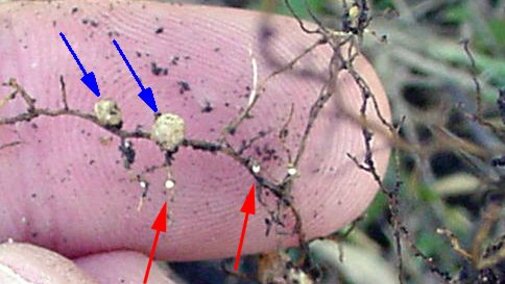July through August is a good time to check soybean fields for soybean cyst nematodes (SCN), the most devastating pest for soybean growers in Nebraska and across the United States.
Yield losses of 25-30% have been documented in fields with no visible injury on the soybean plants. That is why detection of SCN is so important. You need to know if it is present in your field so you can start managing it if it is there.
SCN cysts develop on soybean roots about a month after soybeans emerge and by now may have been on roots in infested fields for a month or more.
Later in the season you may become aware of more subtle signs of an SCN problem. A field with SCN may have dark green, healthy-looking plants, but there can be a slight variation in height. The areas with SCN may be slightly shorter than surrounding soybeans. If conditions become dry, these pockets may wilt while the rest of the field may not. Often wilting may not occur even if SCN is present.
Detecting SCN
There are two ways to detect SCN in fields: a close visual observation of the root system and a soil sample analyzed for the presence of SCN.
For a visual inspection, dig up plants and examine the root system for cysts. Cysts are the only stage in this nematode’s life cycle that can be seen without a microscope. Look for a small, lemon-shaped, white to cream colored "bump" on the outside of the root (Figure 1).
These may be confused with nodules that contain the nitrogen-fixing bacteria normally found on a soybean root. The cyst is much smaller, oblong, and lighter in color than nodules. When scouting fields, if you don't find cysts, you cannot be sure that your field is SCN-free. However, if you DO find cysts, you know you have the pest and need to take action to reduce its buildup in the soil and the resulting yield losses.
A visual examination can confirm its presence, but it does not give you a measure of the level of SCN in the soil. For a more definitive determination you’ll need to take a soil sample, much as you would sample for fertilizer recommendations. Take 15-25 cores from a field, mix them together, and then take a small sample from this mixture.

The cyst is the female nematode that lived inside the soybean root. As it develops eggs, it swells up and ruptures through the root wall. Each cyst can contain up to 400 eggs. Some eggs are released in the soil and the life cycle repeats every 25-28 days.
Because SCN has several generations each growing season and because it is a prolific egg producer, the population of SCN can build up dramatically in a field in one season. Even though the SCN population may not be high enough to cause yield damage this year, it can build up to levels where it will cause problems the next time soybeans are planted, even if there is a year or two of corn between the two soybean crops.
Yield as an Indicator of SCN
The University of Nebraska has had 29 research sites comparing SCN-resistant and SCN-susceptible soybean varieties in fields infested with SCN and 11 sites where the same varieties were planted in fields with no SCN. In infested fields, resistant varieties out-yielded susceptible varieties by an average of about six bushels per acre for about a 10% yield increase. In fields where SCN was not present, susceptible varieties out-yielded resistant varieties by an average of two bushels per acre.
Unlike with other pests, SCN damage to a plant often isn’t obvious. Frequently, lower yields are the first indication that something is wrong. Soybean yields in a given field may hit a plateau or even drop for no apparent reason such as weather or herbicide damage, while corn yields in the same field continue to improve.
Another sign is when low-yielding areas on a yield map can’t be attributed to soil type, weed or insect infestations, compaction, or other yield-limiting factors.
Neither of these indicators is a guarantee there is SCN in the field, but it would be one of the first things to check.
More Information and Free Analysis
For more information about scouting for SCN, what to do if you have it in your fields, or for bags to submit soil samples for a free SCN analysis (worth $20 per sample), contact your local Nebraska Extension Office. Also see the Soybean Cyst Nematode section in the Plant Disease Management section of CropWatch.

